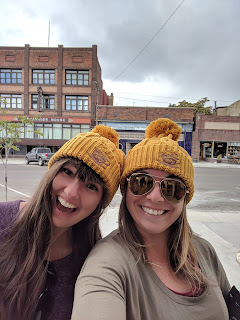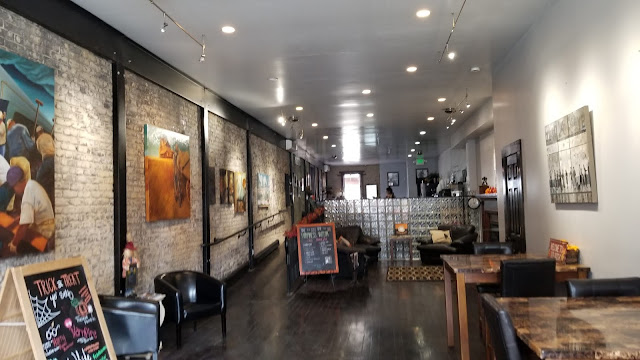Where to eat and sleep in Carbon County
Unfortunately that’s all we got to try that weekend but other honorable mentions based on local recommendations include:
1. Greek Streak for your Mediterranean craving
2. Los 2 Amigos
3. Sherald’s Drive in
Sleeps 4, book through AirBnb
Upscale apartment located in a historic 1918 building on Helper’s main street. Within walking distance to the local, market, two restaurants, art galleries, museum, the river walkway and everything else Helper’s historic main street has to offer.
Sleeps 4, book through AirBnb
Helper House is a cozy, single level home located on Helper’s Historic Main Street. Located close to the River Walkway, this charming house is in an ideal location for all of your explorations in Central Utah. Across the street is our famous “Big John”, Utah’s tallest coal miner, and less than 10 miles away is the USU Eastern Prehistoric Museum. You also will have a front row seat for the annual Helper Arts Festival and Utah’s Christmas Town’s Main Street Light Parade.
Artist’s River House $115/night
Sleeps 4, book through AirBnb
100 year old family home, restored with modern aesthetic yet maintaining original charm. King bed in bedroom with fold-down couch in living room and floor space for air mattress.
One block from historic downtown Helper with easy access to two diners, western mining and railroad museum, artist studios and antique shops.
2 Bedroom House $59/night
Sleeps 6, book through AirBnb
Entire upstairs of a house with Stylish decor – stainless appliances, warm blue interior paint, laminate flooring, & full tile shower with glass surround. An affordable place for a whole family.
Airbnb Guest Suite $35/night
Sleeps up to 5 guests, book through AirBnb
A 375sq ft space with a private secure entrance and private bathroom. There are no shared spaces. There’s a king size bed, sleeper sofa, and space for additional travellers! Perfect for budget minded travelers looking for a clean, safe and cozy space. Enjoy WiFi and Netflix.
Desert Thunder Stock Car Races
A few days relaxing in Stonington Borough
After the craziness of flying multiple times within less than a week and seeing SO many sites, a couple days of R&R at my gal pal Katie’s house was definitely due. She lives in the cutest little New England town called Stonington Borough. Monday,Tuesday, and Wednesday I spent the majority of my days sitting on the couch like a bum blogging and trip planning but I did make it out on the town when it wasn’t raining.
As Katie lives right on the edge of the borough, no car needed to explore the town which is itty bitty and very walkable. Points of interest: Museum Lighthouse and Stonington Point (for history buffs) the shops and little streets for those looking for shopping or charm, and of course the cute little beach! (which I was dying inside that it turned so cold for the time I was there. I really wanted to swim!)
The museum is just before you reach Stonington Point and while I’d like to claim I went in, the $10 entry price was a bit steep to me for the size but for here’s a bit of info on it: The lighthouse itself was built in 1840 and was in active service until 1889 when beacons were added to the breakwaters, but even then it housed the light keepers until 1909 when it was abandoned. It was purchased by the historical society and made into a museum in 1927 and houses numerous lighthouse artifacts (from other lighthouses) and
other pieces of maritime history. Most interesting artifacts involve cannonballs and artifacts from when the British attacked Stonington in 1814 (part of the war of 1812, more on that later) It has been open 6 months every year since then (besides most of WWII which I found interesting) and visitors can climb the 29 steps to the top where the view lends itself to 3 states.
Hours of operation: May 5 – October
Open Daily from 10am – 5pm, CLOSED Wednesday
And as I was saying just past the lighthouse you reach the point with a fun little beach and wonderful bench area! I had a lovely relaxing sit watching a few divers come in on the beach.
(still wish it had been warm enough to swim.. or sunny to sit on the beach but alas, I was cursed with no great weather… more on that later. haha)
One of my favorite things about this town is how so many of the building have the date they were constructed and who the original family is plus their occupation. As this was a seaport you can imagine a large majority of the “big” houses were Captains, rope makers, and merchants. The oldest house I came across was 1767!
Also I didn’t tack this onto Sunday’s Boston post (cause well it was after we got back from Boston) But I had an AMAZING time riding Katie’s horse, Bradley in Old Lyme. For those of you who know me, you know I LOVE animals and I’ve loved horses forever, Having such a terrific friend like Katie, finally gave me the kick in the pants to finally start taking lessons. Those lessons paid off big time when I got to ride her beautiful horse! (and not fall off him cause he was seriously HUGE)
So cost breakdown: (and I apologize cause this is INCREDIBLY convoluted as I’ve split my Connecticut activities into multiple posts with more to come.) Basically priceless on everything!
Lodging: Wonderfully comfortable bed in a guest room at Katie’s mansion of a cute old house
Meals: I ate groceries all day long and will have more info on the post on Mystic from when we went Happy hour hopping there: But I think we can just round to like $35 for 2 dinners out…. (This is not very exact… I apologize)
And walking around Stonington was obviously a free activity (with more Connecticut free activities to come!)
Total cost for Monday-Wednesday: $35ish








































